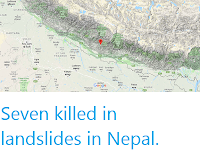Seven people are missing following a landslide on Mount Annapurna, Nepal, on Saturday 18 January 2020. The missing are described as three South Korean tourists, two men and a woman in their fifties, plus a woman in her thirties, plus three Nepalese tour guides. Several other parties of hikers who were in the area at the time were evacuated safely, but rescuers were unable to locate the missing party on Saturday, and could not return to the area due to poor weather, until late on Sunday, when it was found that their last known location was covered by snow five metres deep. It is thought unlikely that they have survived.
Rescue workers on Mount Annapurna, Nepal, on 18 January 2020. Phurba Ongel Sherpa/AP.
Avalanches are caused by the mechanical failure of snowpacks; essentially when the weight of the snow above a certain point exceeds the carrying capacity of the snow at that point to support its weight. This can happen for two reasons, because more snow falls upslope, causing the weight to rise, or because snow begins to melt downslope, causing the carrying capacity to fall. Avalanches may also be triggered by other events, such as Earthquakes or rockfalls. Contrary to what is often seen in films and on television, avalanches are not usually triggered by loud noises. Because snow forms layers, with each layer typically occurring due to a different snowfall, and having different physical properties, multiple avalanches can occur at the same spot, with the failure of a weaker layer losing to the loss of the snow above it, but other layers below left in place - to potentially fail later.
Diagrammatic representation of an avalanche, showing how layering of snow contributes to these events. Expedition Earth.
Mount Annapurna is a 55 km long massif reaching 8091 m above sealevel at its highest point, with sixteen more peaks that reach over 6000 m above sealevel, making it the tenth highest mountain in the world. Annapurna was the first mountain over 8000 m to be climbed (by Maurice Herzog in 1950), and is popular with both climbers and trekkers. Nonetheless, the mountain is considered to be one of the most dangerous high mountains in the world, with 61 known fatalities since 1990 (exceeded only by Mount Kangchenjunga, also in Nepal), including 43 people killed in a single storm in October 2014, which triggered a series of avalanches in areas popular with tourists.
Nepal is located entirely within the Himalayas, a range of mountains formed by uplift associated with the collision between the Indian and Eurasian tectonic plates. The Indian Plate is moving northwards at a rate of 5 cm per year, causing it to impact into Eurasia, which is also moving northward, but only at a rate of 2 cm per year. When two tectonic plates collide in this way and one or both are oceanic then one will be subducted beneath the other (if one of the plates is continental then the other will be subducted), but if both plates are continental then subduction will not fully occur, but instead the plates will crumple, leading to folding and uplift (and quite a lot of Earthquakes). The collision of the Indian and Eurasian plates has lead to the formation of the Himalayan Mountains, the Tibetan Plateau, and the mountains of southwest China, Central Asia and the Hindu Kush.
See also...
Follow Sciency Thoughts on Facebook.









